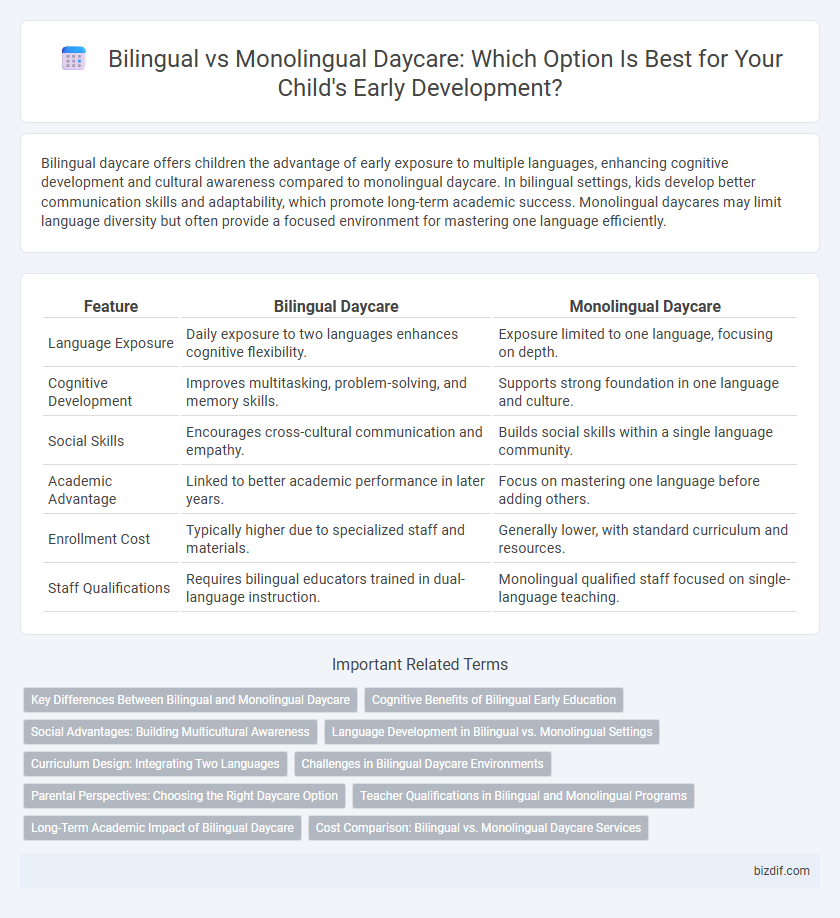Bilingual daycare offers children the advantage of early exposure to multiple languages, enhancing cognitive development and cultural awareness compared to monolingual daycare. In bilingual settings, kids develop better communication skills and adaptability, which promote long-term academic success. Monolingual daycares may limit language diversity but often provide a focused environment for mastering one language efficiently.
Table of Comparison
| Feature | Bilingual Daycare | Monolingual Daycare |
|---|---|---|
| Language Exposure | Daily exposure to two languages enhances cognitive flexibility. | Exposure limited to one language, focusing on depth. |
| Cognitive Development | Improves multitasking, problem-solving, and memory skills. | Supports strong foundation in one language and culture. |
| Social Skills | Encourages cross-cultural communication and empathy. | Builds social skills within a single language community. |
| Academic Advantage | Linked to better academic performance in later years. | Focus on mastering one language before adding others. |
| Enrollment Cost | Typically higher due to specialized staff and materials. | Generally lower, with standard curriculum and resources. |
| Staff Qualifications | Requires bilingual educators trained in dual-language instruction. | Monolingual qualified staff focused on single-language teaching. |
Key Differences Between Bilingual and Monolingual Daycare
Bilingual daycare centers offer an immersive environment where children are exposed to two languages, promoting cognitive flexibility and early language acquisition, while monolingual daycares focus exclusively on one language, enhancing depth of vocabulary and cultural context in that language. The curriculum in bilingual daycare integrates dual-language instruction and cultural diversity, whereas monolingual daycare emphasizes mastery of a single language through focused communication and literacy activities. Caregiver language proficiency and linguistic environment are critical in bilingual settings to support balanced bilingualism, contrasting with the monolingual approach that fosters native fluency and linguistic consistency.
Cognitive Benefits of Bilingual Early Education
Bilingual daycare programs enhance cognitive development by promoting improved executive functions, such as problem-solving, multitasking, and mental flexibility, compared to monolingual settings. Children exposed to multiple languages from an early age exhibit stronger memory retention and increased attention control, fostering better academic performance. These cognitive benefits support long-term advantages in language acquisition and overall intellectual growth.
Social Advantages: Building Multicultural Awareness
Bilingual daycare environments promote social advantages by fostering multicultural awareness and enhancing children's ability to communicate across cultures. Exposure to multiple languages encourages empathy, adaptability, and a broader understanding of diverse perspectives, which are less prevalent in monolingual daycare settings. Children in bilingual daycares develop stronger interpersonal skills that prepare them for globalized social interactions and inclusive communities.
Language Development in Bilingual vs. Monolingual Settings
Bilingual daycare environments enhance cognitive flexibility and executive function development by exposing children to two languages simultaneously, facilitating advanced language processing skills compared to monolingual settings. Research shows that children in bilingual daycares develop stronger metalinguistic awareness and improved problem-solving abilities, promoting more robust language acquisition. Monolingual daycares primarily support vocabulary growth and language fluency in a single language but may offer limited opportunities for cross-linguistic transfer and diverse communicative competence.
Curriculum Design: Integrating Two Languages
Bilingual daycare curriculum design integrates two languages by embedding dual-language instruction throughout daily activities, promoting cognitive flexibility and cultural awareness from an early age. Monolingual daycare focuses on a single language, typically following age-appropriate milestones and language immersion strategies to develop fluency and comprehension. Research shows that bilingual curriculum models enhance executive function and linguistic skills more effectively than monolingual approaches.
Challenges in Bilingual Daycare Environments
Bilingual daycare environments present unique challenges such as language confusion and slower initial speech development as children navigate multiple languages simultaneously. Caregivers must be highly trained in dual-language instruction to support effective communication and cognitive growth. Maintaining consistent language exposure at home and daycare is critical for balanced bilingual proficiency and avoiding language dominance.
Parental Perspectives: Choosing the Right Daycare Option
Parents often weigh the benefits of bilingual daycare, appreciating its role in fostering early language acquisition and cultural awareness, against monolingual daycare's emphasis on immersion in a single language for consistency. Research indicates bilingual daycare can enhance cognitive flexibility and social skills, aligning with parental goals for global readiness. Ultimately, the choice hinges on family language goals, community context, and the child's adaptability to diverse linguistic environments.
Teacher Qualifications in Bilingual and Monolingual Programs
Teacher qualifications in bilingual daycare programs typically include proficiency in two languages and specialized training in language acquisition to support effective bilingual development. Monolingual daycare programs generally require expertise in early childhood education focused on one primary language, emphasizing developmental milestones within that linguistic context. Qualified educators in bilingual settings often have certification in TESOL or bilingual education, ensuring culturally responsive teaching approaches.
Long-Term Academic Impact of Bilingual Daycare
Bilingual daycare environments enhance cognitive flexibility and executive function, leading to improved problem-solving skills and greater academic achievement in later years. Studies show children exposed to two languages early develop superior reading and vocabulary abilities, contributing to higher standardized test scores. Long-term benefits include increased cultural awareness and better adaptability in diverse educational settings, positioning bilingual daycare as a valuable foundation for academic success.
Cost Comparison: Bilingual vs. Monolingual Daycare Services
Bilingual daycare services typically incur higher costs than monolingual daycare due to the need for specialized staff fluent in multiple languages and tailored educational materials promoting language development. The increased expenses cover language-specific curriculum design and immersive learning environments, which support advanced cognitive and social skills. Families often balance these costs against the long-term benefits of bilingual proficiency and cultural exposure offered by bilingual programs.
Bilingual daycare vs Monolingual daycare Infographic

 bizdif.com
bizdif.com